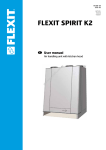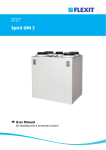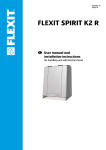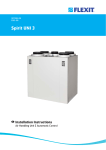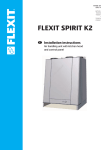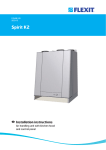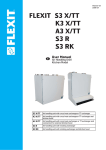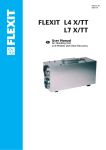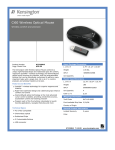Download User Manual
Transcript
111139E-07 2015-11 Spirit K2 User manual Air handling unit with kitchen hood Contents 1 2 Functional Description 1.1 Heating element 1.2 Operation of kitchen hood Cleaning/Maintenance 4 4 4 5 CI60 simple control unit 3 4 CI60 control unit overview CI60 in use 4.1 General 4.2 Increasing/reducing air supply 4.3 Adjusting the air supply 4.4 Temperature adjustment 4.5 Filter replacement 4.6 Alarm 4.7 Reset 8 9 9 9 9 9 9 9 9 CI60 advanced control unit 5 6 CI600 control unit overview CI600 in use 6.1 General 6.2 Idle mode 6.3 Menu navigation 6.4 Start menu 6.5 Operating status CI600 main menu 7.1 Fan speeds 7.2 Max. timer 7.3 Settings 7.4 Temperature 7.5 Timer 7.6 Daily/weekly timer 7.7 Time and date 7.8 Language 7.9 Filter 7.10 Alarm 7.11 Operating information CI600 advanced user menu 8.1 PIN 8.2 Advanced user 8.3 Temperature regulation 8.4 Configuration 8.5 Operating time 10 11 11 11 11 11 11 12 12 12 12 12 13 13 14 14 14 14 14 15 15 15 15 17 18 9 Maintenance table 10 Troubleshooting 11 EC Declaration of Conformity 19 20 21 7 8 2 ! Important Safety Instructions: It is the installer's responsibility to carry out a full safety and function assessment of the appliance To reduce the risk of fire, electric shock or injury, read all the safety instructions and warning texts before using the appliance. • • • • • • • • • This unit is only designed for ventilation air in buildings. It must not be used to extract combustible or flammable gases. Remove the power plug before commencing any service and maintenance work. Before opening the door, current to the unit must be turned off and the fans must have had time to stop (min. 3 mins.). The unit contains heating element which must not be touched when it is hot. The unit must not be operated without the filters being in place. Do not cook substances which could catch fire under the ventilator. Do not leave a saucepan or frying pan containing oil or grease unsupervised. Follow the instructions in the user manual. To maintain good indoor air quality, comply with regulations and to avoid condensation damage the unit must never be stopped apart from during service/maintenance or in connection with an accident. Symbols Used HIGH VOLTAGE These products bear a number of symbols used for labelling the actual product and in installation and user documentation. Supply air DANGER! DO NOT TOUCH Extract air SAFETY SWITCH ! Exhaust air CAUTION When a text bears this symbol, it means that personal injury or serious damage to the equipment may result if the instructions are not followed. Outdoor air NB! When a text bears this symbol, damage to equipment or a poor utilisation ratio may result if instructions are not followed. This appliance can be used by children aged from 8 years and above and persons with reduced physical, sensory or mental capabilities or lack of experience and knowledge if they have been given supervision or instruction concerning use of the appliance in a safe way and understand the hazards involved. Note that the product is not intended for use by children. Children shall not play with the appliance. Cleaning and user maintenance shall not be made by children without supervision. Our products are subject to continuous development and we therefore reserve the right to make changes. EXAMPLE OF NIPPLE LOCATION (shown as right-hand model) We also disclaim liability for any printing errors that may occur. Our products are subject to continuous development and we therefore reserve the right to make changes. We also disclaim liability for any printing errors that may occur. 3 1 Functional Description See page 19 for component description. Cold outdoor air passes through one half of the rotor (HR-R), while warm extract air passes through the other half, without the two mixing. Using this principle, a large proportion of the heat in the extract air is transferred to the supply air the heat store principle (see system sketches). If the outdoor temperature is extremely low, a thermostat-controlled heating element (EB1) also ensures that the supply air has the desired temperature. This supply air is passed via ducts and valves to living rooms and bedrooms. The extract air is extracted either from the same room or via door gaps/ overflow gratings to toilets and wet rooms. The used air is passed via a duct system back to the unit, gives off its heat and is expelled from the building via a roof cowl, combi-box or wall grating. When there is no need for heat recovery (for example in the summer), the rotor stops. 1.1 Heating element The heating element is protected against overheating by the thermostat (F20), which switches off at 60°C. As an additional safety measure, the thermostat (F10) switches off at 85°C. Thermostat F10 needs to be reset manually by pressing the reset button. You will find the thermostat by opening the unit doors (located directly over the heating element). 1.2 Fig. 1 Operation of kitchen hood A - Knob for damper and for forced ventilation B - Pushbutton for light When cooking, open the damper by turning damper switch A. 1) Turn the knob to level 1. The damper will be half open. 2) Turn the knob to level 2. The damper will be fully open. 3) Turn the knob to level 3 and the unit will increase the air volume to speed 3 (forced ventilation). 4) You will need to turn the damper back manually (when cooking is finished). 2 B 1 0 This is purely a ventilation system and not a heating system. The home must be heated in the normal manner. B 4 3 A 2 Cleaning/Maintenance Fans: The fans must be cleaned once a year. Clean the fan blades with a grease solvent on a cloth - or with brush and compressed air if possible. NB! Do not use water. Before opening the door of the heat recovery unit or carrying out maintenance on the kitchen hood: switch off the heat, let the fans continue for three minutes to remove hot air, disconnect power from the unit and wait 2 minutes before opening the doors. ! ! If the kitchen hood is used often, the extract air fan must be checked and if necessary cleaned every four to six months. Remember first to remove the safety lock at the top of the door. Dismantle the fan as follows: Open the doors as instructed. EC fan: Release the screw at the front of the fan. Pull out the electric quick-release contact for the motor. The fan can now be pulled carefully down and out of the unit. safety lock Filters: To preserve a healthy indoor air quality, it is important to change filters when they are dirty. Dirty filters lead to: Increased air resistance in the filter – less air in the home – risk of bacterial growth in the filter – in the worst case scenario, the system can be damaged. ! ! 2 How often the filters need to be changed depends on the degree of contamination of the air where they are installed. In general, the filters need to be changed once a year, preferably in the autumn (after the pollen season). In areas with a lot of dust and contamination, the filters should be changed in the spring and autumn. The supply air filter and extract air filter consist of a compact filter (F7). These are pushed into place. It is recommended that you order a filter subscription to ensure full benefit from the system and the cheapest prices. Remember that the door is heavy (10 kg) when lifting it off the unit. 1 When changing the filter, check that the whole unit is working normally. Rotor: As the unit has filters with a high impermeability class installed, it is not usually necessary to clean the rotor. If for various reasons it should still be necessary, dust can be removed with a soft brush. Further cleaning is possible if you remove the rotor, spray it with fat-soluble detergent and then blow it clean from the opposite side. Distance approximately 60mm and max. pressure 8,0 bar. Ensure that the motor is not exposed to water during cleaning. Ensure that all seals around the rotor are intact and tight. 3 Fig. 2 1. Hold the door by its upper edge, which has a recessed grip. 2. Pull the door to release it from its catch. 3. Change your grip and lift the door off. NB! The door weighs 10 kg. 5 External cleaning: Many kitchen surface cleaners contain chemicals that may damage the product’s plastic components. Therefore use a soft cloth moistened with warm water and a neutral detergent to clean the outside of the product. Important! Do not use abrasive cleaners or scouring powder, as they will damage the colour. Products that give stainless steel an anti-fingerprint coating must not be used either. Do not use detergent that is harmful to aluminium or the environment. Mounting of door: Fig. 3 C 2 1 1. Lower the front edge of the door into the leading edge of the unit. 2. The guide pins on the door must pass through the base of the unit. 3. Push the top edge of the door to lock it. ! CAUTION! For safety reasons, always mount the door screw when you’re finished maintaining the ventilation unit! 6 3 To change the fluorescent tube, remove the lamp glass by pressing the snap locks in the direction of the arrow, Fig. 6. The fluorescent tube can now be accessed for replacement. Kitchen hood: Wipe the volume hood with a damp cloth and detergent. The filter must be cleaned roughly twice a month with normal use. International Philips Osram ILCOS code designation designation Dismount the filter (see figs. 4 and 5) and place it in hot water with washing-up liquid. The filter cassette can also be washed in the dishwasher. Several times a year the volume hood should be cleaned internally. Wipe it internally with a damp cloth and detergent. Replace the filter cassette and press it up so that it fixes to the snap locks. ! The risk of fire increases if the volume hood is not cleaned as often as specified. Light source FSD-11-G23 PL-S 2-pin DULUX-S Power 11W 11W 11W Earth G23 G23 2-pin G23 2-pin Fig. 6 Fig. 4 Fig. 5 7 3 CI60 control unit overview 8 3 4 9 1 5 10 2 6 11 7 12 No. Description No. Description 1 Switch for increased ventilation 8 2 Switch for decreased ventilation Potentiometer for adjusting extract air at NORMAL speed 3 Indication of MAX speed 9 Potentiometer for adjusting supply air at NORMAL speed 4 Indication of NORMAL speed 10 Switch for additional heating OFF/ON 5 Indication of MIN speed 11 6 Indication of ALARM Potentiometer for adjusting supply air temperature 7 Indication of FILTER REPLACEMENT 12 Switch to reset the alarm *The figures are used as references in subsequent descriptions 8 4 CI60 in use 4.1 General 4.4 Temperature adjustment The control unit consists of a touch panel with pushbuttons, LEDs for indication and adjustment potentiometers and switches for adjusting the ventilation unit. The control unit communicates with the ventilation unit via a low-voltage cable. The temperature required in the supply air can be set with potentiometer 11. The adjustment range is 10 - 30 °C. Using the factory settings is recommended. If necessary, the ventilation unit’s additional heating can also be switched OFF/ON with switch 10. 4.2 Increasing/reducing air supply ON Use switches 1 and 2 to increase and reduce the fan speed and thus the air flow. Different speeds depending on the operating situation. MIN Do not use during first year of operation, or when the building is in use. NORMAL Used under normal conditions. In this setting, the air supply must be adjusted according to current regulations. MAX Used if there is a need for increased air supply on account of increased occupancy or a higher humidity level, for example during showering or when clothes are being dried. This setting is usually used for limited periods of time. ITEM 10 4.5 Filter replacement Every six months, LED 7 lights up to remind you that it is time to replace the air filters in the unit. See section 3 for more information on filter replacement. After the activity has been carried out, the indicator must be reset. See more under the Reset section. 4.6 Alarm ! If anything unforeseen occurs with the ventilation unit, indicator 6 lights up. The signal given by the indicator depends on the reason for the indication. The different speeds are indicated with LEDs 3, 4 and 5. 4.3 Adjusting the air supply A permanent light indicates: Fault return water detector (B5) • Heat recovery fault (B) At NORMAL speed level, the air flow must be adjusted according to project data. Potentiometer 9 is used for the supply air level and potentiometer 8 for the extract air level. The adjustment range is 20-100% of the maximum level according to the scale of the potentiometer. • A permanent light with indicator 5 (MIN speed) flashing indicates: • Fault supply air detector (B1) • Fault extract air detector (B3) • Fault outdoor air detector (B4) Factory settings: MIN 50% (fixed) NORMAL 75% (variable) MAX 100% (fixed) 9 8 10 11 OFF A flashing light indicates: • Overheating thermostat fault (applies only to electric heating) • Fault in external fire/smoke detector (accessory) • Heat recovery fault (A) • Additional heating fault (applies only if the unit has a water battery) 4.7 Reset After the filter has been replaced or the cause of the alarm repaired, the alarm must be reset. This is done by pressing switch 12. If the indicator goes out, the action has been carried out correctly. If the indicator remains on, the fault has not been repaired correctly. 9 5 CI600 control unit overview 6 1 7 2 8 3 9 4 5 No. Description 1 UP/INCREASE switch 2 BACK/CANCEL/NO switch 3 DOWN/DECREASE switch 4 OK/YES switch 5 HELP switch 6 Display 7 Indication of OPERATION/OK - Green light 8 Indication of FILTER REPLACEMENT - Yellow light 9 Indication of ALARM - Red light *The figures are used as references in subsequent descriptions 10 6 CI600 in use 6.1 General If you select a function that has numerical values, the current value is displayed with a light blue cursor. The value is changed with buttons 1 and 3 and is then confirmed by pressing button 4. The control unit consists of a colour display, a touch panel and indicators (LEDs). The unit communicates with the ventilation unit via a low-voltage cable. 6.2 Idle mode TIME AND DATE If the touch panel is not used, the control unit will, after a certain period of time, enter idle mode, in which operating information will be displayed. B A TIME DAY MONTH YEAR 13 : 45 04.07.09 04 07 09 C OK? 13.08.2009 16:43 18°C 22°C If several values can be changed, the cursor jumps to the right when a selection is confirmed with button 4. The procedure is repeated until all values have been changed to the desired values. - NORMAL If you want to cancel a function or return to the previous menu screen, use button 2. D A. B. C. D. E. F. E F Button 5 activates a help text that briefly describes the current menu screen. Time and date Outdoor air temperature Room temperature Current speed Additional heating activated/deactivated Daily/weekly timer active 6.4 Start menu When the system is started, a start menu is opened. START MENU 6.3 Menu navigation LANGUAGE TIME AND DATE MAIN MENU Buttons 1 and 3 are used to navigate through the menu lines. The cursor is illustrated by the line being light blue. If it is possible to make a selection on the current menu line, this is displayed with OK? to the right of the line. A selection is confirmed by pressing button 4. If a menu line contains submenus, this is illustrated with a ‘>’ sign at the end of the line. OK? > > SETTINGS TEMPERATURE TIMER DAY/WEEK SETTINGS TIME AND DATE LANGUAGE FILTER ALARM ADVANCED USER OPERATING INFORMATION The basic language and date settings are set in this menu. When this activity has been carried out, you choose to go to the main menu. > > OK? > > > > > > 6.5 Operating status In normal operation without problems, the green LED 7 lights up to confirm that everything is working normally. How any problems affect the system is described in subsequent sections. 11 7 CI600 main menu 7.1 Fan speeds 7.2 Max. timer This menu item activates a function that increases the speed to MAX for a limited period of time before subsequently returning to the speed selected previously. The period of time can be adjusted under the SETTINGS menu item. The main menu contains various choices. Most concern fan speeds. The speed selected is indicated with large fan symbols and bold font. MAIN MENU MIN NORMAL MAX MAX TIMER SETTINGS MAIN MENU MIN NORMAL MAX MAX TIMER OK? OK? > SETTINGS > To change the speed, move the cursor with buttons 1 and 3. When the function is active, the time is counted down on the display. If you select TIMER OFF, the function will be cancelled and the speed will return to the previous selection. MAIN MENU MIN NORMAL MAX MAX TIMER 7.3 Settings OK? Under the SETTINGS menu item, you can adapt the system as you want. SETTINGS SETTINGS > TEMPERATURE TIMER DAY/WEEK SETTINGS TIME AND DATE LANGUAGE FILTER ALARM ADVANCED USER Then confirm your selection with button 4 and the speed selected is highlighted with large fan symbols and bold font. MAIN MENU MIN NORMAL N MAX M MAX TIMER M > > OK? > > > > > OK? 7.4 Temperature Here you set the temperature for the air that enters the building. SETTINGS > TEMPERATURE 18 °C HEATING ELEMENT ON/OFF 12 OK? > 7.6 Daily/weekly timer We recommend adjusting the temperature to max 18° so that the air is mixed optimally with the air already in the building. The programming of the timer begins by selecting the day. DAY / WEEK SETTINGS In the HEATING ELEMENT OFF/ON menu item, the additional heating in the ventilation unit can be switched off. In such case, only the rotating heat exchanger is used as a source of heat. MONDAY TUESDAY WEDNESDAY THURSDAY FRIDAY SATURDAY SUNDAY NB! This is not possible if the unit is installed with a water battery. If the heating element is switched off, this symbol is displayed when the display enters idle mode. OK? A new menu screen appears under each day. HEATING ELEMENT ON/OFF TUESDAY HEATING ELEMENT ON OK? 7.5 Timer MIN 16° 2 16 : 00- 18: 00 NORMAL 18° 3 18 : 00-19 : 00 MAX 16° 4 19 : 00-24 : 00 NORMAL 18° Each day can be programmed with four different time intervals. Adjust the start and stop times for each interval and then adjust the desired speed and temperature. To activate the interval, select a green tick. A red cross means that the interval is not activated. If necessary, then select another interval and repeat the procedure. NB! The following rules apply to the programming: • A time interval with a higher number can never be started before a previous one has been finished. • The stop time can never appear before the start time. Here you set the time you want for the MAX TIMER function. This is used when the function is activated from the main menu. TIMER 60 min 1 08: 00-16 : 00 OK? After you have finished programming a day, repeat the procedure for other days. When the timer is active, this symbol is displayed when the display enters idle mode. If there is no new time interval registered after the finished period, the speed and temperature return to the setting that was previously active. 13 7.7 Time and date INTERVAL CHANGE OF FILTER The time and date can be adjusted in this dialog. TIME AND DATE TIME DAY MONTH YEAR 13 : 45 04.07.09 04 07 09 6 MND OK? OK? The normal time is 6 - 12 months, depending on the environment. When the filter alarm is triggered, the yellow indicator 8 lights up and an information text appears. Follow the instructions in the text. It is possible to go directly to this dialog from the message or via the menu tree. After the alarm has been reset, the countdown to the next filter replacement begins. 7.8 Language The language selected can be changed in this dialog. LANGUAGE NORSK ENGLISH SVENSKA DEUTCH NEDERLANDS SUOMI DANSK 7.10 Alarm If a problem occurs in the operation of the ventilation unit, an alarm will be triggered. The red indicator 9 lights up and an information text appears in the display. Follow the instructions in the text. It is possible to go directly to this dialog from the message or via the menu tree. OK? ALARM OK? RESET ALARM 7.9 Filter A reminder appears regularly in the display. In this dialog, the time interval can be adjusted and the filter alarm reset. FILTER INTERVAL CHANGE OF FILTER RESET FILTER ALARM 7.11 Operating information > OK? This general screen displays current temperature values, whether the daily/weekly timer is active and activity as 0-100% for cooling, heat exchanger and additional heating. OPERATING INFORMATION SET TEMPERATURE DAY / WEEK SETTINGS SUPPLY AIR EXTRACT AIR OUTDOOR AIR RETURN WATER HEAT RECOVERY SYSTEM COOLING HEATING 14 22° AKTIV 22° 21° 0° 35° 100% 0% 100% 8 CI600 advanced user menu 8.3 Temperature regulation NB! For more information on the ”Advanced User” menu, refer to the ”CI600 Reference Manual” on Flexit’s homepage. In this menu screen, you configure the temperature regulation and cooling functions. TEMPERATURE REGULATION 8.1 PIN REGULATION TYPE COOLING NEUTRAL ZONE EXT. TEMP. CONTROL To access the menu item, you need to enter the PIN 1 0 0 0. PIN CODE 1 0 0 0 > > OK? > OK? Regulation type If supply air regulation is selected, no further settings can be set here. If extract air regulation is selected, the max. and min. supply air temperatures can also be specified. REGULATION TYPE 8.2 Advanced user REGULATION MAX SUPPLY AIR TEMP MIN SUPPLY AIR TEMP This menu contains functions for monitoring, configuration and troubleshooting. EXTR OK? 35° 15° ADVANCED USER TEMPERATURE REGULATION FAN REGULATION CONFIGURATION OPERATING TIME FACTORY SETTINGS SERVICE > OK? > > > > Cooling NB! Flexit does not supply or project cooling machines. In this dialog, the cooling function is activated and the parameters MIN OUTDOOR AIR TEMP for supply of cooling and MIN SPEED for supply of cooling are specified. If a DX cooling machine is used, the supply delay interval can be specified. COOLING COOLING MIN OUTDOOR TEMP MIN SPEED RESTART DELAY COOLNESS RECOVERY 15 AV OK? 18° MIN 180 s > It is also possible to activate a function to recover cooling in the building using the rotating heat exchanger. Enter the desired difference between the outdoor and indoor air temperatures for when the function is activated. Fan control The fans are selected and configured in this menu screen. FAN REGULATION SUPPLY AIR EXTRACT AIR TIMER AIR VOLUME COMP COOLNESS RECOVERY COOLNESS RECOVERY DIFF OFF 1° OK? Adjustment (supply air and extract air) This dialog is identical for the supply air and extract air fans. The fans are adjusted individually to the desired capacity for the respective speed. Neutral zones To achieve more even temperature regulation, the neutral zones can be set in this menu. SUPPLY AIR NEUTRAL ZONE COOLNESS RECOVERY HEAT RECOVERY SYSTEM 2° 1° MIN SPEED NORMAL SPEED MAX SPEED OK? Factory settings: External temperature control Control of the temperature settings from an overall system must be entered in this menu. In this case, the temperature settings in the control unit are overridden. EXT. TEMP. CONTROL EXT. TEMP. CONTROL OFF > > OK? > OK? 16 MIN 5V NORMAL 7,5V MAX 10V 50% OK? 75% 100% 8.4 Configuration Timer Settings are entered in this menu for the speed and time that are to apply to the ‘MAX TIMER’ function in the main menu. The general configuration is set in this menu screen. CONFIGURATION TIMER STANDARD SPEED STANDARD TIME MAX OK? 30 m Sensors The temperature sensors can be calibrated in this menu to be better coordinated with the real situation, and a pressure sensor is activated as a pressure guard instead of the integrated time control. Air flow rate compensation This function can be activated via an input on the control card. The speeds required for each fan are selected here. The function can be used with a kitchen fan or other device that requires additional supply air. SENSORS > > OK? > > SUPPLY AIR EXTRACT AIR OUTDOOR AIR RETURN WATER FILTER GUARD AIR VOLUME COMPENSATION SUPPLY AIR EXTRACT AIR > > OK? > > SENSORS FIRE/SMOKE COMMUNICATION START/STOP SEQUENCE REST MODE MAX OK? MIN The menu screen is identical for all temperature sensors and they can be adjusted within an interval of 5 °C. SUPPLY AIR CALIBRATION 17 0 OK? If the pressure guard is activated, an external sensor must be connected to the control card. The sensor replaces the integrated filter time control. Communication Proceed to the ‘HOME/AWAY’ submenu. COMMUNICATION FILTER GUARD ACTIVATION HOME/AWAY OFF The settings are entered for the AWAY selection. Speed and temperature can be selected, plus how long after activation the new setting should take effect. Fire/Smoke This function requires an external sensor to be connected to the control card. Standby mode In this menu you can adjust the time it takes before the display enters idle mode. FIRE/SMOKE MODE OK? OK? 1 OK? REST MODE TIME DELAY Supply air fan Extract air fan 1 Mode STOP STOP 2 MAX MAX 3 STOP MAX 4 MAX STOP 2 min OK? 8.5 Operating time This menu screen displays the ventilation unit’s total operating time and how much time has passed since the last filter replacement. OPERATING TIME OPERATING TIME FILTER 18 312 tim 125 tim 9 Maintenance table Component Filters Interval Filters should be changed at least once a year. You are advised to change them twice a year. 6-12 months Before and after the pollen season. Check that the filter seal is completely tight. Fans Fans should be cleaned at least once a year to maintain fan efficiency. If the kitchen hood is used often, the extract air fan must be checked and if necessary cleaned every four to six months. Heat exchanger Check that the surfaces are clean. Check that the sealing strips lie in against the heat exchanger. 12 months Make sure that rotor driving belt is in good condition and well adjusted. 12 months Kitchen hood Wash the grease filter. Check that the damper is clean and closes fully. 2 weeks Seals Check that the seals in the unit are intact. 12 months Valves To be cleaned at least once a year. 12 months Air intake Check that no leaves and other items are caught in the grille. 12 months Roof cowl If the unit has a roof cowl, this must be checked for leaves and the like. 12 months 4 months Also check that the drain slots are open. Ducts Check that the ducts are clean. 10 years 19 10 Troubleshooting In the case of a power cut, the unit will automatically return to normal operation (user's settings) when starting up again. The unit has a safety switch which cuts off power when the door is removed. Type of fault: Remedial action: Cold draughts Check which supply temperature has been selected. See operating panel. Check that the rotor is rotating. Check that heating comes on. Needs new extract filter. Fans not working Check that the power to the unit is connected. Check that the overheating thermostat has not cut out. Reset by pressing the button. Also needs correcting on the automatic control panel. Check that the unit has not been set in stop position. Low air volume Check the speed the unit is set to. Check that the filters fit tightly. Check the intake grille. If none of this helps, please contact your supplier for service. Please state the model designation and serial number (on the rating plate inside the unit/open door). 20 11 EC Declaration of Conformity This declaration confirms that the products meet the requirements in the following Council Directives and standards: 2004/108/EF Electromagnetic Compatibility (EMC) 2006/95/EF Low-voltage Directive (LVD) Our products have been tested in accordance with parts of: 2006/42/EC Machinery Directive (Safety) Manufacturer: FLEXIT AS, Televeien 15, 1870 Ørje, Norway Type: K2 R Ventilation unit Conforms to following standards: Safety standard EN 60335-1:2012 + A11 EMF standard: EN 62233: 2008 EMC standard: EN 55014-1.2006 + A1 + A2 EN 61000-3-2: 2006 + A1 + A2 EN 61000-3-3: 2013 EN 55014-2:1997 + A1 + A2 The product has been CE-marked: 2011 FLEXIT AS 16.02.2011 Frank Petersen CEO The right to give notice of lack of conformity applies to this product in accordance with the existing terms of sale, provided that the product is used and maintained correctly. Filters are consumables. The symbol on the product shows that this product must not be treated as household waste. It must be taken to a reception station for recycling of electric and electronic equipment. By ensuring the correct disposal of the equipment, you will contribute to preventing the negative consequences for the environment and health that incorrect handling may entail. For further information on recycling of this product, please contact your local authority, your refuse collection company or the company from which you purchased it. Notice of lack of conformity as a result of incorrect or defective installation must be submitted to the installation company responsible. The right to give notice of lack of conformity may lapse if the system is used incorrectly or maintenance is grossly neglected. 21 a 22 a 23 Flexit AS, Televeien 15, N-1870 Ørje www.flexit.no
























